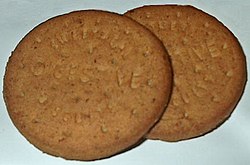Digestive biscuit

A digestive biscuit, sometimes referred to as a sweetmeal biscuit, is a British semi-sweet biscuit. The name "digestive" comes from a belief that the biscuits had antacid properties due to the use of bicarbonate of soda when they were first conceived.
Ingredients
The typical digestive biscuit contains coarse brown wheat flour (which gives it its distinctive texture and flavour), partially hydrogenated vegetable oil, sugar, wholemeal, cultured skimmed milk, partially inverted sugar syrup, raising agents, and salt. A biscuit averages around 70 calories, although this sometimes varies according to the factors involved in its production.
Consumption
Digestive biscuits are frequently eaten in the UK with tea or coffee. Often, the biscuit is dunked into the tea and eaten quickly due to the biscuit's tendency to disintegrate.
Each year, 71 million packets of these are sold in the United Kingdom, which corresponds to 51 biscuits eaten per second. Digestives are also popular in cookery for making into bases for cheesecakes and similar desserts.
Chocolate digestives
Chocolate digestive biscuits also are available, coated on one side in plain, milk, or white chocolate. Originally produced by McVitie's in 1925, other recent varieties include the basic biscuit with chocolate shavings throughout, or a topping of caramel, mint chocolate as well as chocolate. The US travel writer Bill Bryson described the chocolate digestive as a British masterpiece.[citation needed]
See also
External links
- Digestive biscuit review from nicecupofteaandasitdown.com
- Chocolate digestive biscuit review from nicecupofteaandasitdown.com
